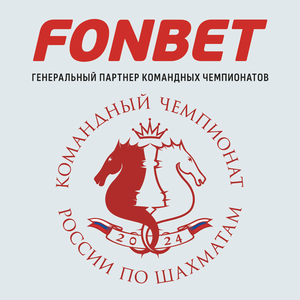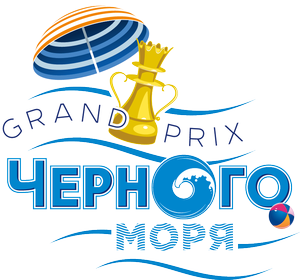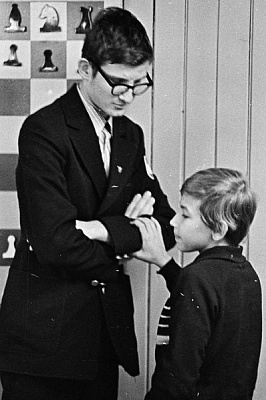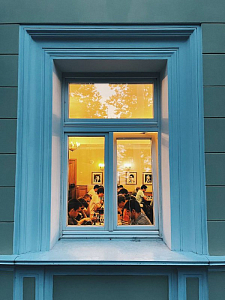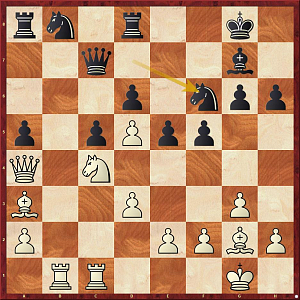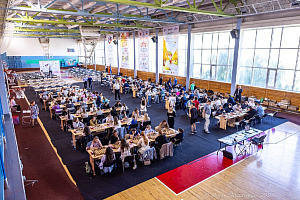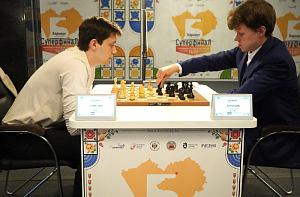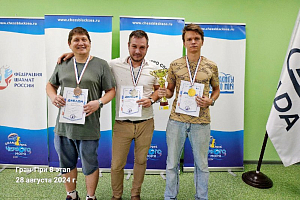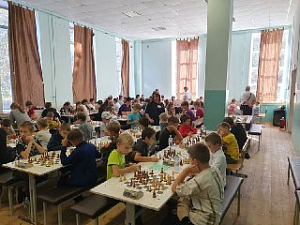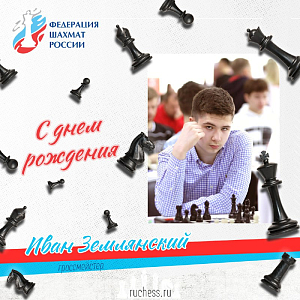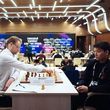13 September 2016
The Great Confrontation
Round Eight of the Baku Olympiad is reported by Vladimir Barsky.
The double match Russia - USA became the pivotal event of round eight: both men's and women's teams of the two countries faced each other on top tables. The tables were close to each other on the stage, only 5-6 meters separating these battles. By chess standards, these games stirred an incredible excitement with photographers densely surrounding the leaders’ table where Sergey Karjakin and Fabiano Caruana were about to start challenging each other. Snapping prestart handshakes is considered a special chic and has probably come down from the synchronized swimming, which all viewing fans are known to be so fond of.
The Dream team was significantly beefed up prior to the start of the 2016 Olympiad: besides Hikaru Nakamura the Stars and Stripes are now represented by Fabiano Caruana and Wesley So, all of them being players of the top ten. However, the experienced Gata Kamsky and Alexander Onischuk, who could serve as great defenders of the last board, did not arrive in Baku as part of the team. Thus, the Americans featured an obvious Achilles’ heel: despite Sam Shankland and Ray Robson’s are undoubtedly very talented, they cannot boast stable performance just yet. While Shankland is considered a lucky person - suffice it to have a look at his game against Sethuraman from round seven covered in our review “Ring Dances around the Kings” - Robson, on the other hand, is a more solid player. The Americans probably believed it was high time that indefinite luck pushing be stopped and decided to put Robson on board four to hold Grischuk to a draw with the white pieces. Now, let us begin a story of the chess match from board one.
It was Sergey Karjakin and Fabiano Caruana who contested victory in the recent (or in the distant past, as someone might feel like thinking!) Candidates Tournament in Moscow. Then Sergey won the last round game through a spectacular rook sacrifice. Once again, the white pieces are with the Russian grandmaster, whose performance is steady at the capital of Azerbaijan. Meanwhile, same cannot be claimed about Caruana, who miraculously bailed out from plight against Harikrishna the day before.
Karjakin – Caruana
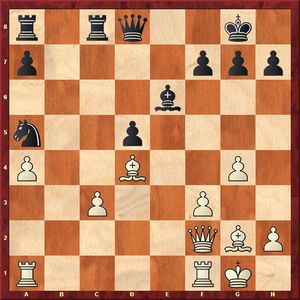
Karjakin has successfully handled the opening into a very promising position and is now launching the attack against the king.
27. f4! Nb3
It goes without saying that the pawn should not be taken: 27...Bxg4 28. Qg3 h5 29. h3, while 27...f6 28. g5 is no less risky than that. Caruana makes up his mind to swap the menacing d4-bishop.
28. f5 Bd7 29. Rad1 Nxd4 30. Rxd4 Qf6 31. Qg3!
White is striving at delivering checkmate. On the other hand, White’s attempts at winning material by 31. Bxd5 Bc6 32. c4 would empty out his offensive potential. Thanks to the exposed position of the g1-king Black would have excellent chances of making a draw there.
31...Qb6 32. f6 Be6 33. Qe3 Kh8
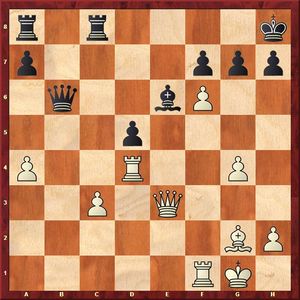
34. Kh1
White wastes momentum. A lot more powerful is the straightforward 34.fxg7+ Kg8 35.g5! with the idea of launching a queen and rook attack against h7 or carrying out the g5-g6 stab. Now, the seemingly active 35...Rc4? runs into 36. a5! Qc5 37. g6!, and White wins. 35...Re8 is strongly met by 36. Qd3 Rac8 37. Rf6! with threats of Rh6 or Bxd5, whereas 36...Rab8 (preventing activation of the f1-rook due to the trade of queens on b1) is answered by 37. Kh1 - unpinning the rook and preparing its transfer to h4.
34...Rg8 35. c4
It appears that this move has to do with some sort of miscalculation. 35. fxg7+ Rxg7 36. Qe5 would be extremely unpleasant for Black.
35...Rad8 36. a5 Qxa5
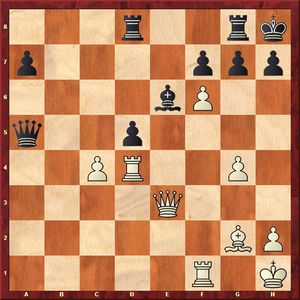
37. Qe5
White might have calculated the following nice line: 37. cxd5 Bxd5 38. fxg7+ Rxg7 39. Bxd5 Rxd5 40. Qe8+ Rg8 41. Qxf7 Rxd4 42. Qf6+ Rg7 43. Qxd4 winning, but on closer inspection he found out the more stubborn 41... Rdg5! rejoinder (in lieu of taking on d4) 42.Qf6+ R5g7 - Black has consolidated to render his defense impregnable. Meanwhile, after the text move the worse for Black is over as well.
37...Rde8 38. cxd5 Bd7 39. Qd6 Qd8 40. h3 Bb5 41. Qxd8 Rxd8 42. fxg7+ As White’s advantage has shrunk to a symbolic one only, Karjakin offered a draw.
Vladimir Kramnik easily and gracefully equalized against Hikaru Nakamura in a classical Queen’s Gambit. On move 20 Black got rid of his only weakness, an isolated d-pawn, and even enjoyed some slight initiative in the subsequent game; however, nothing substantial could be squeezed out of it because of the enormous safety margin of the rook ending.
Ian Nepomniachtchi is the only member of the Russian team who played all seven games without rest, scoring seven straight victories along the way. Even though a brilliant result has undoubtedly filled both Ian and his fans with positive emotions, fatigue has been accumulating that can easily mask itself behind an emotional uplift. Being in charge of the white pieces, Ian obviously felt obliged to go into a big fight, but Wesley‘s performance was simply outstanding that day.
Nepomniachtchi – So
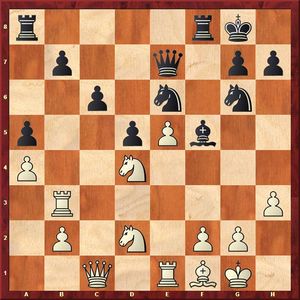
23. Nxf5
It would have been a proper treatment of the position had the white pawn stood on a3, whereas now the situation is different and White should have traded knights instead: 23. Nxe6 Bxe6 24. g3 Rf7 25. f4 Raf8, and now 26. Qd1!, preventing the undermining advance h7-h5-h4. Even though Black is able to sacrifice a knight - 26...Nxf4!? 27. gxf4 Rxf4, after 28. Bg2 any result is possible.
23...Rxf5 24. Bd3 Rf4! 25. Bxg6 hxg6 26. Qd1
26. Rg3 Raf8 27. Nf3 Rxa4 28. Rxg6 Nf4 brings no relief either.
26...Raf8 27. Rf3 Qb4
This is when the weakened b4-square makes itself felt.
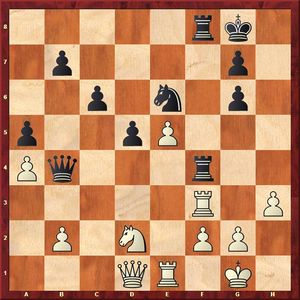
28. Rxf4
The pawn cannot be saved since after 28. b3? Rd4 29. Rxf8+ Kxf8 30. Re2 Nf4, the knight is a goner.
28...Rxf4 29. Nf3 Qxa4 30. Qd3 Rf5, and Black managed to convert his material advantage.
Alexander Grischuk levelled the match score. His opponent opted for the “reinforced concrete” anti-Berlin line with a symmetrical pawn structure and was meticulous in trading each piece that was possible to trade, but towards the time pressure period he gave way nonetheless, allowing Grischuk outplaying him almost for no reason at all.
Robson – Grischuk
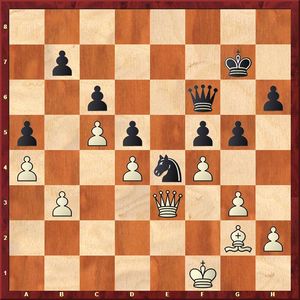
White emerged with a bishop pair advantage out of the opening, but then Alexander succeeded in trading the dark-squared bishops so that his centralized knight is clearly superior to the opponent’s g2-counterpart.
36…gxf4 37. gxf4 Qh4 38. Bxe4?
It loses by force. The defense was to be maintained by 38. Bh3, although White’s position has undoubtedly turned into a difficult one already.
38...fxe4 39. Qf2
Another version of the pawn ending is hopeless either: 39. Qg3+ Qxg3 40. hxg3 Kg6 41. Kf2 (or 41. g4 h5 42. g5 h4 - Black has the so-called self-propelled pawns) 41...Kf5 42. Kg2 Kg4 43. Kf2 h5, followed by h5-h4. However, even with queens on the board White will not hold out since after the black king’s arrival on f5 the f4-pawn is doomed.
39...Qxf2+ 40. Kxf2 Kf6 41. Kg3 Kf5 42. h3 h5 43. h4 e344. Kf3 e2 45. Kxe2 Kxf4 46. Kd3 Kg4 White resigns. The final score is 2-2 and probably reflects the true balance of forces.
After the Tromsø Olympiad the women’s USA team has also added in strength owing to merging into its ranks a pupil of the Palace of Pioneers on the Vorobyovy Gory (Sparrow Hills), the 2010 Moscow champion Nazi Paikidze. Recently she became the United States champion and was trusted one of the top boards - board two. Meanwhile, board one featured the seasoned Irina Krush.
The match started on an extremely favorable note for the Russian girls as at all four boards they achieved a tangible opening advantage. Although Olga Girya sacrificed two pawns to Katerina Nemcova and could develop a strong kingside attack, she kept her own monarch in the center for some unknown reason. By creating her own counter-threat Nemcova managed to stabilize the position while retaining extra material .Then she changed over to the offensive to give her team a lead in the match.
The score was levelled by Valentina Gunina, who once again reminded us all how important it is to treat chess horses with affection.
Paikidze – Gunina
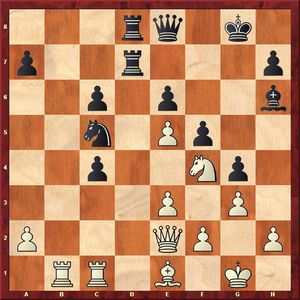
27…Nd3 28. Rxc4 Nxe5 29. Rc5 Nf3+
This is a cozy place for the knight! It took Black another twenty moves to break through with a heavy piece onto the opponent’s home rank to have this knight joined by the rook.
30. Kg2 Rd6 31. h4 Bf8 32. Ba5 R8d7 33. Rbc1 e5 34. Qc4+ Qf7 35. Ne2 Rd5 36. Rxd5 cxd5 37. Qc8 Kg7 38. Bc7
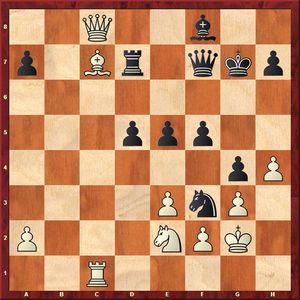
38…d4! 39. exd4 Ba3 40. Rc3 Bb4 41. Rc1 Ba3 42. Rc3 exd4 43. Rxa3 Rxc7 44.Qb8 Rb7 45. Qd6 Rd7 46. Qc5 Rc7 47. Qa5 Re7 48. Qc5 Re5 49. Qxa7 Rxe2 50.Qb6 Re1 White resigns.
Natalija Pogonina spilled her substantial opening advantage, while the game of leaders saw a genuine tragedy.
Kosteniuk – Krush
The 12th World Champion enjoyed a solid advantage through the first half of the game, but then performed indecisively and the tenacious defense allowed Krush to equalize chances. Kosteniuk could have forced a draw, but continued playing for victory and overdid it as the exchange sacrifice, attempted by her, proved too risky. Black seized the initiative, but with almost all fighting units having left the board the resulting position was a fortress. The fate of the battle was sealed in the second time trouble period by a one-move blunder.
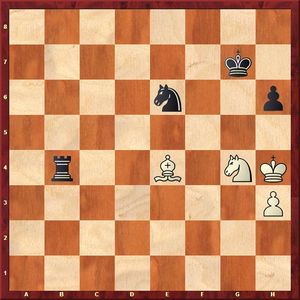
67. Bg2??
Retreating the bishop to f3 or c6 would have kept White in the game.
67…h5!, and White resigns in view of 68.Kxh5 Nf4+.
“h5, h5!” - cheerfully shouting at the dinner was the American women’s team captain Yasser Seirawan. As for Alexandra Kosteniuk, upon having had a quick snack she headed for a many-kilometer evening jog along the light-flooded Primorsky Boulevard full of idle public. Alexandra Kosteniuk’s endurance and stamina are inspiring and admirable!
We continue acquainting our audience with participants’ feedback on the Olympiad.
Ioannis Papaioannou (Greece):
- The first time I played for our national team was in 1998, and since then I have played in every one of them I must say that this is one of the best, if not the best. It is very well organized, the hotels are really great.
Irina Krush (USA):
- I’ve got to say, Baku is a beautiful city. I’m really happy with the tournament hall, the location of the hotel – it’s very close to the center. I always walk back from the games because I really like that walk by the water. I find it pretty relaxing after the end of the day. So, I like Baku a lot; the old town is a beautiful place to walk around in.
Pictures by Boris Dolmatovsky and Vladimir Barsky








